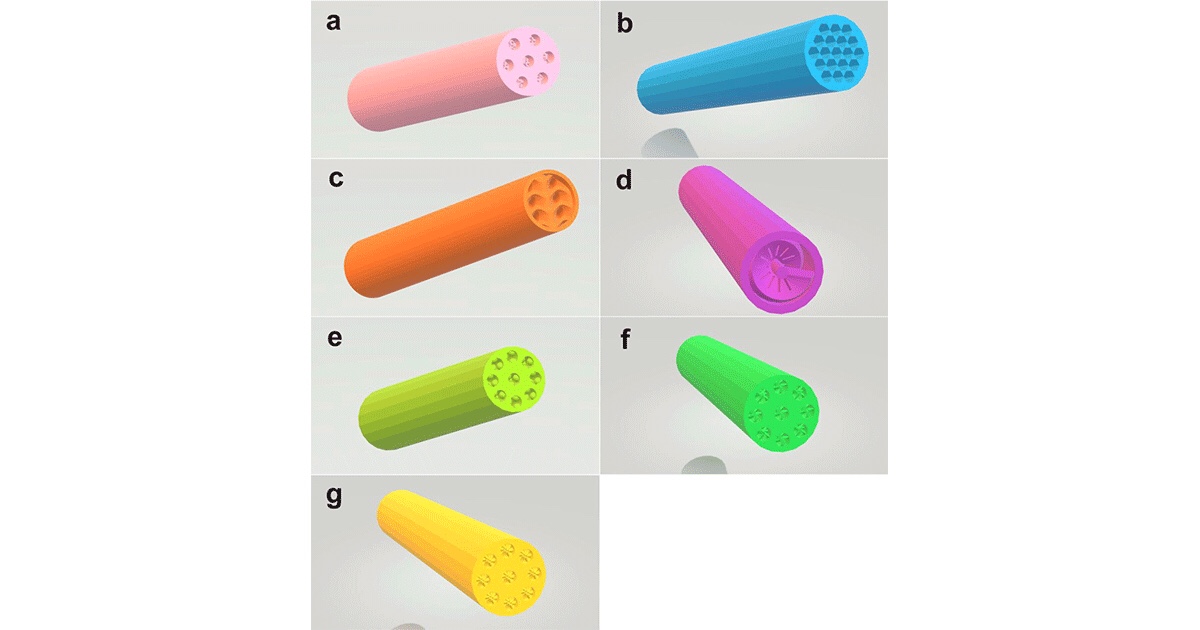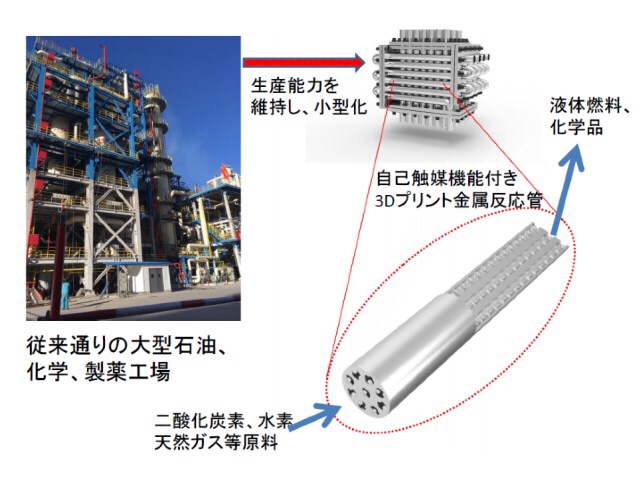

Toyama Univ.: Made with 3D printer: Reaction vessel with catalyst
Toyama University:
In collaboration with the National Institute for Materials Science (NIMS), we succeeded in producing the “metal catalyst reactor with autocatalytic function” for the first time in the world.
“Metal catalytic reactor with autocatalytic function”:
This metal-catalyzed reactor was created using laser processing and a 3D printer.
This reactor can be used under severe conditions of high temperature and high pressure.
Fabrication of 3D metal reaction tube:
Laser melting jet and computer program control are used together.
Using stainless steel, metal, and alloy as raw materials,
Spinal structure, monolith structure (multiple parallel tubes),
3D metal reaction tubes with various spatial structures can be manufactured.
Add catalytic activity points to fine metal surface:
Next, chemical treatment or oxidation/reduction treatment is performed on the fine metal surface.
We have succeeded in creating catalytic active points on the internal fine metal surface.
Miniaturize the reactor itself:
The inner surface of this metal reaction tube can be used as a catalyst as it is.
It is not necessary to fill the bulky supported catalyst with the conventional method.
The reactor itself has been dramatically reduced in size.
Actual application example:
High-speed continuous synthesis of gasoline and light oil:
High-speed continuous synthesis of gasoline and light oil from carbon dioxide and hydrogen using an iron 3D catalytic reaction tube,
High-speed production of gasoline and light oil from synthesis gas using cobalt or iron 3D catalytic reaction tubes
Rapid continuous production of syngas:
Rapid continuous production of synthesis gas from carbon dioxide and natural gas using a nickel 3D catalytic reaction tube,
“In the high-temperature, high-pressure catalytic reaction, the reactivity comparable to that of the conventional technology was demonstrated.”
Synthetic liquid fuel plant:
Submarine methane hydrate:
If applied to a synthetic liquid fuel plant that is produced offshore, it is possible to produce offshore natural gas and methane hydrate, as well as various energy products and chemical products.
Biomass to liquid fuel:
In addition, the company says that it will be possible to reduce the size and cost of the synthetic reaction from carbon dioxide or biomass to liquid fuels and chemicals.
OPTRONICS ONLINE
http://www.optronics-media.com/news/20200817/67029/
Metal catalyst reactor with autocatalytic function: Made by 3D printing technology
-High temperature and high pressure reaction possible, dramatically downsizing plant-
High temperature/high pressure type large reactor:
Many chemical industry plants use large high-temperature, high-pressure reactors packed with large amounts of supported catalysts.
Innovative reaction processes and equipment are required to reduce the cost and size of catalysts and equipment, and to save energy.
Professor Tsubaki, Research Group:
Utilizes 3D printing technology of high melting point metal using laser melting jet technology.
We have succeeded in producing a metal reactor with a precisely controlled fine structure.
Microstructure, metal reactor:
Next, by chemically treating the inner surface, we added a catalytic function to the fine metal surface, leading to the creation of a “metal catalyst reactor with an autocatalytic function”.
This reactor can be used under high temperature and high pressure conditions as well as conventional catalytic reactors.
Catalytic function on fine metal surface:
With this technique,
There is no need to fill the reaction tube with a supported catalyst,
Many catalytic reactors can be downsized,
This will lead to a reduction in capital investment and catalyst costs.
In addition, the plant itself can be dramatically compacted.
Compact the plant itself:
In the prior art, the next production method required space and was impossible.
Offshore production
On-vehicle production
It can also be applied to production on ships.
Application reaction example:
Carbon dioxide hydrogenation, liquid hydrocarbon fuel synthesis,
Reforming reaction of methane and carbon dioxide, etc.
Achieves high activity and long catalyst life in reactions under high temperature and high pressure conditions.
Use of seabed methane hydrate:
Also, in the use of seabed methane hydrate, which Japan is leading the world,
A wide range of applications can be expected, including high-speed production of offshore liquid synthetic fuels.
National Institute for Materials Science (NIMS):
A patent application for this technology has been filed by the University of Toyama (application number: Japanese Patent Application 2020-93320)
This research is conducted by National Institute for Materials Science (NIMS)
It was jointly conducted with Toyama University.
The results of this research will be published on August 14, 2020 (UK time) in the online bulletin of the British science magazine “Nature Communications.”
https://www.jst.go.jp/pr/announce/20200814/index.html
Metal 3D printing technology for functional integration of catalytic system
Published: 14 August 2020
Qinhong Wei, Hangjie Li, […]Noritatsu Tsubaki
Nature Communications volume 11, Article number: 4098 (2020) Cite this article
Metrics detailsNature Communications
Abstract
Mechanical properties and geometries of printed products have been extensively studied in metal 3D printing.
However, chemical properties and catalytic functions, introduced by metal 3D printing itself, are rarely mentioned.
Here we show that
metal 3D printing products themselves can simultaneously serve as chemical reactors and catalysts (denoted as self-catalytic reactor or SCR) for direct conversion of C1 molecules (including CO, CO2 and CH4) into high value-added chemicals.
The Fe-SCR and Co-SCR
successfully catalyze synthesis of liquid fuel from Fischer-Tropsch synthesis and CO2 hydrogenation;
the Ni-SCR efficiently produces syngas (CO/H2) by CO2 reforming of CH4.
Further,
the Co-SCR geometrical studies indicate that metal 3D printing itself can establish multiple control functions to tune the catalytic product distribution.
The present work
provides a simple and low-cost manufacturing method to realize functional integration of catalyst and reactor, and will facilitate the developments of chemical synthesis and 3D printing technology.